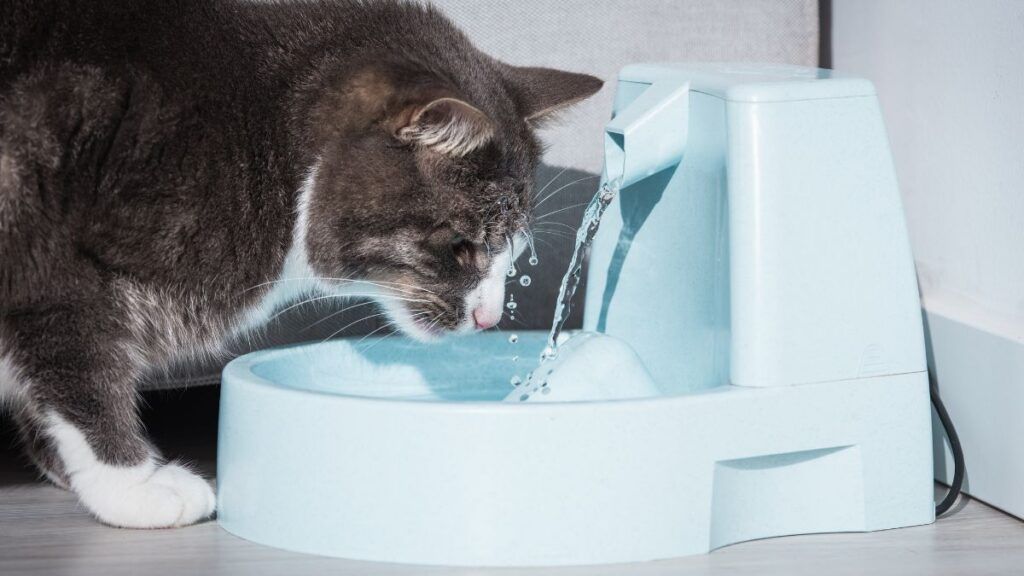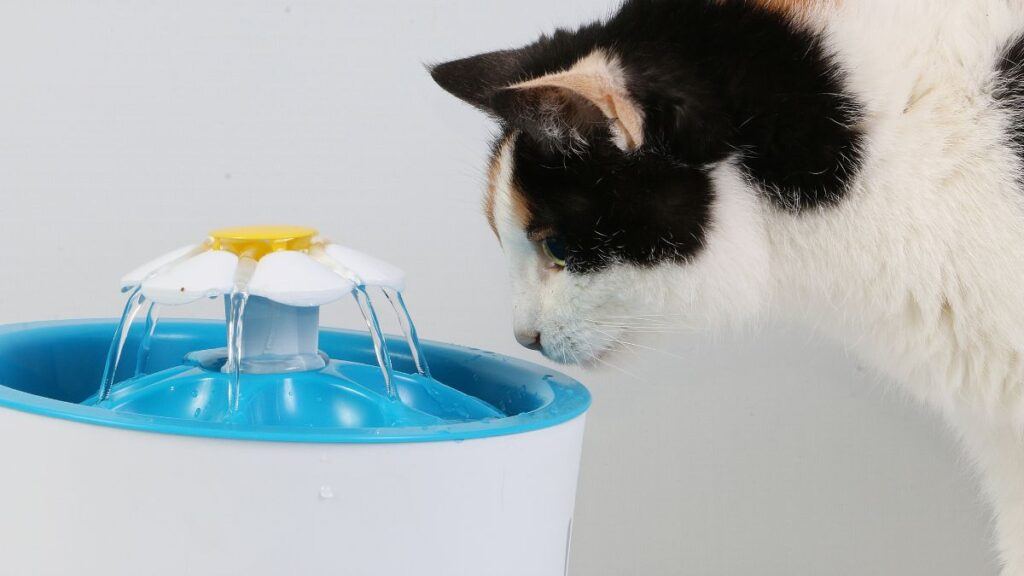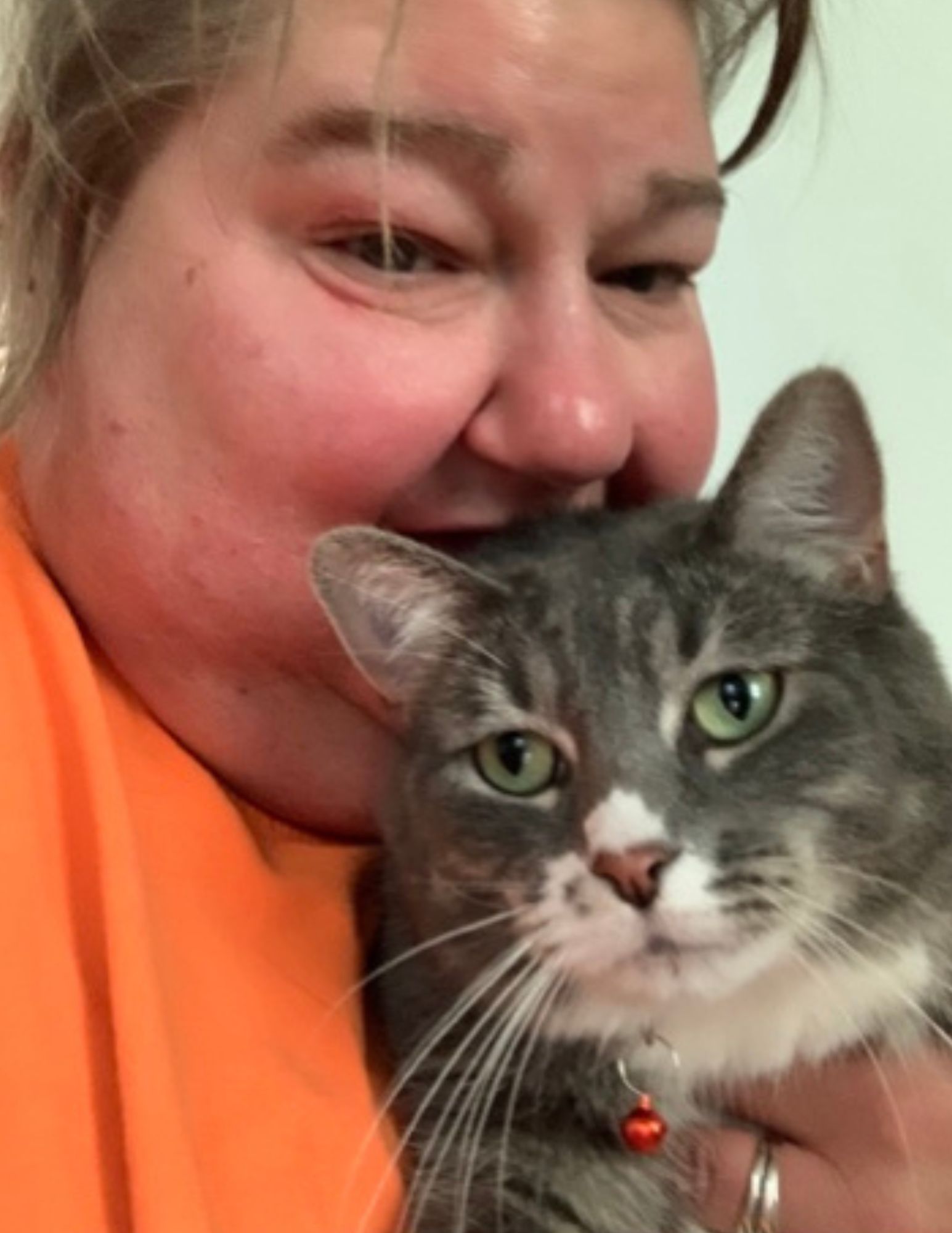In the quest for optimal pet care, many cat owners have turned to cat water fountains to provide their feline friends with a constant source of fresh water.
However, these devices offer numerous health benefits, from encouraging cats to consume enough water to reduce the risk of kidney stones and urinary tract infections, but they are not without risks.
Critical considerations include the potential for bacteria growth in stagnant water, the importance of choosing cat fountains that adequately meet a cat’s needs, and the overall safety of these devices.
We will explore the operation of cat water fountains, compare them to traditional drinking bowls, and explore the different types available to ensure our beloved pets have safe, clean, and appealing water sources.
Understanding Cat Water Fountains

Cat water fountains provide pets with a continuous flow of fresh water. This section will cover their operation, compare them to traditional bowls, and discuss the available types.
How Cat Water Fountains Work
Cat water fountains are designed to circulate water continually, ensuring that cats can always access fresh water.
Automatic pet water fountains utilize a pump to move water from the reservoir through a filter into a spout or dish accessible to cats.
This circulation helps to keep the water clean and inhibits the growth of bacteria that can occur in stagnant water.
Comparing Fountains to Traditional Water Bowls
Traditional water bowls can allow water to become stagnant, which may deter cats from drinking due to taste or smell.
Conversely, cat water fountains consistently aerate the water, which can help increase a cat’s water intake.
Proper hydration is crucial for feline health, reducing the risk of kidney stones and urinary tract infections.
Types of Water Fountains
There are various types of water fountains available in the market, each with safety considerations:
- Plastic Fountains: Inexpensive but can harbor bacteria if scratched.
- Stainless Steel Fountains: More hygienic, durable, and easier to clean.
- Ceramic Fountains: Aesthetic choice, durable, and also easy to clean but can be heavy.
When choosing a water fountain, consider your cat’s specific needs and its practicality for cleaning and maintenance.
Health and Hydration Benefits

Cat water fountains serve as a source of clean water to promote better health and proper hydration for pets.
They encourage cats to increase their water intake, which benefits their overall well-being.
Preventing Health Issues
Cats often prefer moving water, which signifies freshness, leading to greater consumption and better hydration.
Hydration is key in preventing cat health issues like kidney disease and other organ-related problems.
Proper hydration helps regulate body temperature, digestion, and waste removal.
Urinary Tract Health
Continuous access to clean water can significantly reduce the risk of urinary tract infections and urinary diseases in cats.
This is especially important since such ailments are common in felines. Increased water intake dilutes urine and helps it pass smoothly through the urinary tract.
Advantages of Continuous Water Flow
Fountains provide a constant, clean water source, encouraging cats to drink regularly and maintain optimal hydration levels.
The filtration system in a water fountain ensures that the water is free from impurities and odors, making it more appealing to cats and thus supporting their urinary tract health and reducing the likelihood of kidney disease.
Selecting the Right Fountain

Safety and functionality should be primary considerations when choosing a water fountain for a cat. Factors such as material, size, and filtration are crucial.
Material Safety: Stainless Steel vs. Ceramic vs. Plastic
Materials are essential in the safety of cat water fountains.
Stainless steel fountains are durable and resistant to bacteria, making them a top choice for cleanliness.
While heavier and potentially more aesthetic, ceramic bowls require careful handling to avoid breakage.
Plastic fountains are lightweight and usually cheaper but can harbor bacteria if not cleaned regularly. Materials should not react with water or leach chemicals.
- Stainless Steel: Non-porous, hygienic, higher cost.
- Ceramic: Heavy, may chip, stylish.
- Plastic: Lightweight, cost-effective, requires frequent cleaning.
Appropriate Sizing and Design
The size of the fountain should accommodate the size of your cat.
A larger cat or multiple cats need a fountain with a greater water capacity to ensure a constant supply of fresh water.
Design plays a role in ease of access and comfort; look for a fountain that suits your cat’s drinking habits and posture.
- Small Cat: Compact fountain suffices.
- Large Cat/Multiple Cats: Larger capacity needed.
- Design: This should cater to the cat’s drinking preference.
Filtration Systems and Maintenance
A filtration system is crucial to remove impurities and keep water fresh.
Most fountains utilize carbon filters that need replacing periodically.
The ease of regular cleaning and filter maintenance will affect the fountain’s safety and the quality of your cat’s drinking water.
Choose a fountain with a filtration system that is easy to maintain, ensuring consistent water purity.
- Carbon Filters: Replace regularly to maintain water quality.
- Maintenance: Simple disassembly aids in regular cleaning and filter changes.
Assessing Safety and Risks
When considering the adoption of a cat water fountain, it is crucial to examine the safety aspects, such as electrical hazards, cleanliness, and noise levels, to ensure the well-being of pets.
Potential Electrical Hazards
Cat water fountains involve electrical components, creating a risk of electrical hazards.
Power surges can damage the fountain’s components or, in rare cases, cause a fire if the product is not equipped with a surge protector.
To mitigate this risk, look for fountains with built-in surge protection and keep all connecting cords away from areas where pets can access them.
It’s crucial that the materials used to conceal and insulate wires be safe and resistant to wear and chewing.
Managing Bacteria and Cleaning
Maintaining a clean water source is essential to prevent bacterial growth in fountains.
Over time, slime and biofilm can accumulate, leading to harmful bacteria that pose health risks to pets.
Regular cleaning is necessary to avoid this, as guided by the manufacturer’s instructions.
When choosing a safe fountain, select one with components that are easy to dismantle and clean, made of non-porous materials that reduce bacterial adherence, and consider using water filters to keep the water fresher for longer periods.
Noise Levels and Your Pet’s Comfort
Noise is often overlooked, but it significantly affects how well a pet accepts and uses a water fountain.
High noise levels can stress pets, causing them to avoid the fountain.
Before purchasing, check the decibel levels of the fountain and read consumer feedback to ensure the operation noise is minimal.
A fountain should operate quietly to maintain a comfortable environment, thus encouraging pets to hydrate regularly.
Use and Maintenance Best Practices
Proper use and maintenance routines are essential for ensuring the safety of cat water fountains.
These practices help maintain a high water quality standard and prevent issues arising from neglect or improper use.
Establishing a Cleaning Routine
A cleaning routine must be established to ensure your furry friend’s water fountain provides fresh water and operates correctly. A step-by-step approach is advisable:
- Daily: Check the water level and refill as necessary to prevent the pump from drying.
- Weekly: Disassemble the unit to clean each component. This includes the bowl, water reservoir, and any filters present. Use hot, soapy water, rinse thoroughly, and allow to dry before reassembling.
- Monthly: Replace filters to maintain water quality and remove food particles or debris buildup.
It is crucial to refer to the manufacturer’s instructions, as each model will have specific cleaning and filter replacement requirements.
Addressing Common Questions and Concerns
Owners often have questions regarding the safety and operation of cat water fountains. Here are some frequently asked questions accompanied by straightforward answers:
- Is tap water safe for cat water fountains?
- Yes, tap water can be used, but it should be free of heavy contaminants. Filtered or bottled water is recommended for areas with poor water quality.
- Can food particles contaminate the water?
- Food particles can enter the fountain and should be removed promptly to maintain hygiene and prevent bacterial growth.
- Does the material of the fountain affect water quality?
- Material such as plastic, ceramic, or stainless steel can affect durability and ease of cleaning, but regular maintenance ensures water safety across all materials.
Ensuring Long-term Functionality
A cat water fountain’s longevity is closely related to how well it is maintained. Here are key points for ensuring long-term functionality:
- Maintain the Motor: The pump motor is the heart of the fountain. Keeping it clean will prevent burnout and extend its life.
- Monitor Water Quality: Change the water regularly to provide your cat with fresh water and prevent mineral deposits from forming.
- Choose the Best Option: Select a fountain that fits your cat’s preferences and your ability to maintain it. This can be a simple water bowl or an elaborate water cooler-like system.

Meet Ann Haasnoot, the passionate founder of CatFurLife.com. A lifelong cat lover from Wisconsin, Ann combines her extensive feline behavior and care knowledge with her love for writing. On her website, she shares invaluable insights about cat breeds, care tips, and her experiences with her beloved furbaby, aiming to deepen the bond between cats and their human companions.

